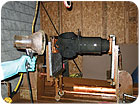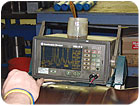
In liquid penetrant inspection, inadequate provision for process control tests is a frequently identified nonconformance. Source: Performance Review Institute
Modern nondestructive testing (NDT) is used by manufacturers for a variety of reasons, such as ensuring product reliability, improving product design, or optimizing manufacturing process control and cost reduction. In today’s economy, the search for increasingly compact, light and fuel-efficient products is more important than ever. Even in the aerospace industry, which has not been as affected as some, there is ongoing emphasis on the need to be as economical as possible while maintaining high quality standards.
Nondestructive testing plays an important role in the aerospace industry and is one of several special processes audited by Nadcap. Nadcap is a cooperative industry effort to improve standards, while reducing costs, through the aerospace and defense industries. Unlike other third-party assessment programs, Nadcap is an industry-managed approach to conformity assessment, bringing together technical experts from industry and government.
The Nadcap NDT task group was first established in 1990. Now led by Chairperson Phil Keown of GE Aviation (Evendale, OH) and Vice-Chairperson Andy Statham of Rolls-Royce plc (Derby, United Kingdom), the NDT task group consists of aerospace prime contractors and suppliers who work together to establish audit criteria, develop supporting documentation and implement process improvements. The prime contractors and suppliers also are responsible for making the final decision on supplier accreditation, based on their root cause corrective action responses to nonconformances identified during the audit, ensuring that the primes retain their accountability.

In advance of the audit, suppliers should identify which test piece is required for magnetic particle inspection and if there is a baseline requirement. Source: Performance Review Institute
Nadcap Trends
There are currently 1,299 Nadcap-accredited NDT suppliers worldwide. Of these, 54% are in the Americas, 35% in Europe and 11% in Asia. This is a shift from 2006 when there were 923 Nadcap accredited NDT suppliers. Their distribution was 64% in the Americas, 29% in Europe and 7% in Asia. This trend will need ongoing study to gage the impact on the industry.Another interesting trend relates to the suppliers who have achieved “merit” status. This means that, dependent on the supplier’s performance in three consecutive audits, the accredited supplier may be eligible to extend the accreditation term from the initial 12 months to 18 months, continuing up to 24 months in cases of superior performance. The benefits for the supplier include having less frequent audits, resulting in less time and costs in pre- and post-audit work as well as the kudos of being recognized by the industry as an excellent special processor.
The Nadcap objective is to have 80% of all eligible suppliers obtain merit status. The data shows that among the Nadcap-accredited NDT suppliers, in the Americas 86% are on merit, in Europe 81% are on merit and in Asia-the newest region to get involved in Nadcap-89% are on merit. Having had more experience and time to achieve merit, it might be expected that Europe would be performing better than Asia, but this is not born out by the data.
Nadcap audits are not intended to be easy: they are a rigorous test designed by the industry to identify the best suppliers and recognize them through Nadcap accreditation. To assist suppliers, training programs provide a review of the Nadcap NDT audit, including topics such as effective audit preparation, Nadcap auditor expectation of compliance jobs and a review and discussion of the most common audit findings.

A common nonconformance in ultrasonic testing is that instrument records do not indicate compliance to baseline, industry or customer requirements. Source: Performance Review Institute
Ultimately, advanced preparation is the key to successful audit performance. According to Larry O’Dell of the Boeing Co. (Chicago), “One hour spent doing pre-audit preparation saves over five hours of work after the audit.”
Mark Aubele, senior Nadcap NDT staff engineer adds, “As the Nadcap audit approaches, ensure that all technicians understand the process that is being used and where to go for help if needed during the audit. If there has been a previous Nadcap audit, review all the nonconformances issued in that audit carefully and verify that all the corrective actions that were implemented are sustaining because the Nadcap auditor will.”

Radiographic testing is one of the NDT methods covered by the Nadcap program. Source: Performance Review Institute
Examples of Common Nonconformances
The following NDT methods are covered by the Nadcap program: liquid penetrant inspection, magnetic particle inspection, radiographic testing and ultrasonic testing. Common nonconformances are often found for each.Solution: Before the Nadcap audit, suppliers should verify that the required process control checks meet the baseline checklist, industry and customer specifications. In addition, a thorough review of all the procedures should be conducted to check compliance to the baseline checklists, industry and customer requirements. Where there is uncertainty, the supplier should contact the customer or NDT task group for objective evidence to clarify the situation.
Periodic checks also should be conducted to verify that the inspectors can perform the checks correctly and understand why they are needed as well as the potential impact of incorrect checks. The results of these checks must be recorded and, where unacceptable results occur, corresponding actions must be documented.
Solution: In advance of the audit, suppliers should identify which test piece is required, such as Ketos ring or AS5282, and if there is a baseline requirement. It also is important to identify if additional equipment such as quantitative quality indicators (QQI) is needed to verify the results within a particular range and at how many points. As with liquid penetrant inspection, the inspector understanding and reporting accuracy is vital.
Solution: First, suppliers should ensure they are aware of all the requirements to determine compliance. If there is no noncompliance, why do the records indicate noncompliance? If an agency is used, is the purchase order clear about the requirements? If the checks are done internally, are they procedurally defined? If there is noncompliance, the reason must be identified: is it due to failed contract or document review, for example? A thorough review of all procedures and purchase orders should be conducted to ensure compliance to the requirements.
Nadcap auditors are “key pillars of the Nadcap process, and provide crucial resources for continual improvement of special processes used in aerospace industry worldwide,” says Chet Daté, director of quality systems and regulatory compliance at Honeywell Aerospace (Phoenix).
Auditing plays a vital role in improving NDT processes and will help manufacturers continue to improve aerospace processes. NDT
Ten Things Required for the Nadcap Audit
1. Provide quality system training-document control, calibration, record keeping, internal auditing-to all employees involved in the audit.2. Make all internal parties aware of the impending audit, calibration, receiving, inspection, purchasing and document control.
3. Make key personnel-management representative, quality manager, level IIIs and calibration technician-available for the audit.
4. Conduct a comprehensive internal (self) audit using the Nadcap criteria, or checklists. Be demanding: it will make things easier later.
5. Collect and review (for compliance) copies of the objective evidence, such as calibration certificates, quality procedures, records, logs and sample job traveler that the auditor will need to review beforehand.
6. Verify that there will be a sufficient number of parts, product and components available for demonstration of proficiency.
7. Review NDT personnel’s competence in performing NDT processes, inspections during the internal audit.
8. Assign knowledgeable escorts for the Nadcap auditor who are to stay with the auditor at all times.
9. Provide the required resources for the audit, such as Internet connection, copier, scanner and office personnel.
10. Advise your customers, internal and external, of the impending Nadcap audit. They also have a vested interest in your success as an accredited Nadcap supplier.




